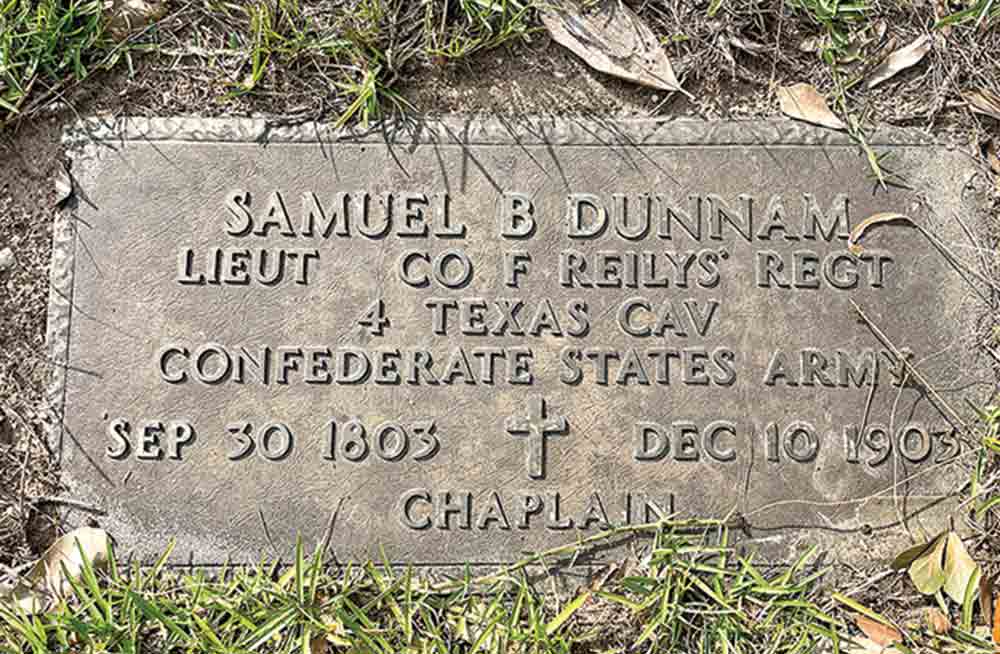
(Editor’s note: First Methodist Church of Livingston is celebrating its 175th anniversary and this milestone will culminate with a celebration on Oct. 22 that will include a combined worship service at 10:30 a.m., a luncheon at noon and a concert that evening. Local Historian Gary Davis has compiled the history of the church and this is the second of a multi-part series that will run on these pages leading up to the celebration.)
By Gary Davis
Methodism was alive and well in Texas and as reported in the 1850 United States census there were 328 churches in Texas. Of this number, 173 were Methodist and were valued at $58,195. Second were the Baptists who owned 70 churches, valued at $23,190. The Presbyterians had 47 that were valued at $20,070. The Roman Catholics only had 13 churches whose valuation was placed at a whopping $79,700.
Polk County was formed on March 30, 1846, as one of the first 23 counties after Texas was annexed into the United States. The original 45 blocks of the City of Livingston were situated on 100 acres of land that was originally donated by Moses L. and Ursula Choate to Polk County on August 8, 1946, recorded in volume A, page 14, for the purpose of becoming the county seat for the site of justice. It is widely accepted that Choate’s offer came with the condition that the town be changed from Springfield to Livingston. The first Polk County Commissioners were James W. Abbey, Arthur P. Garner, B.P. Hardin, A.S. Ainsworth, Frederick H. Rankin and John J. Stubblefield.
It is unclear as to why Choate wanted to change the name from Springfield to Livingston. Some say that his middle name was Livingston. Some say that it was to honor his hometown of Livingston, Tennessee. The 1850 and 1860 census records reflect that he was indeed from Tennessee. Judge J.C. Feagin, when interviewed by the Houston Post on September 22, 1922, advised that Livingston was named for Chancellor Robert Livingston, who administered the Oath of Office to George Washington. And the esteemed Polk County historian, Emma Haynes, stated in her very comprehensive History of Polk County that Choate was from Livingston, Alabama.
The first interment in the cemetery was the Choate’s four-year-old son Josephus, who died on August 11, 1840. Choate later buried a thirteen-year-old son, Rodolphus, in 1846. Choate lived on land just to the east of the cemetery and lore has it that he could see his children’s graves from his cabin.
Regardless of how it got its name, by February 25, 1847, Springfield was known as Livingston. In a deed of this date, recorded in volume A, page 57, the County appointed John English, M.L. Choate, W.L. Dillon, J.R. Jones and M.T. Nettles as trustees to erect buildings for public schools and divine services. The property that was set aside was block 40 plus ¾ of an acre that sat just to the east of the block.
James Andress surveyed the townsite of Livingston and named the streets on a plat that was filed on May 21, 1849, in volume B, page 215. Church Street was likely selected because the county had set aside Block 40 for a church.
When a pastor was assigned a full-time position in a church, often called a station, he was referred to as the Preacher in Charge, or PC. It is widely held that the first PC of the Livingston Methodist church was Samuel Blackwell Bell (S.B.B.) Dunnam. Dunnam, who was born in South Carolina in 1803, later moved to Rapides Parish, Louisiana and came to Polk County in the 1840’s as part of the Louisiana Settlement (Bold Springs/Colita area). During the Civil War, Dunnam, who was in his 60s, answered the call of duty and served as a chaplain and medic. His daughter, Frances Eugenia, married prominent citizen and Livingston Methodist, Judge J.E. Hill, Sr. Reverend Dunnam was 100 years old when he died on December 10, 1903, and is buried in the Old City Cemetery.
In a deed dated October 27, 1859, recorded in volume H, page 562, the County Commissioners, Moses L. Choate, Demetrius Willis and D.D. Moore donated a lot to The Methodist Episcopal Church, South. The Trustees were E.D. Martin, J.A. Bright, J.F. Eckford, Blackwell Dunnam, W.B. Hardin, Alexander Johnson and J.M. Larkin. The lot of ground was in the southeast portion of Block 40 and was 107 feet by 65 feet in size. Within the deed was a promise to erect an edifice for the purpose of religious worship.
From the District Clerk records of September 21, 1859, a contract for the first church building is found. The agreement between church Trustees W.H. Shotwell, J.M. Larkin and J.A. Bright and the contractors Samuel Schooler and Aaron Meekins states that the building will be used as a place of worship for the MEC, S. To be built at a cost of $1,964, the simple frame building was to be 32 feet by 48 feet with a 15-foot ceiling. There were to be eight windows, two doors and three rows of pews which corresponded with the doors, a nice pulpit and a suitable belfry.
This first chapel, which was incredibly captured in several photographs by Ben M. Lewis around 1900, was shared with the Presbyterians and the Baptists for 30 years. Referred to as “everybody’s church,” the building doubled as a schoolhouse and the wife of PC J.A. Smith was one of the teachers.
In the year 1885, the Presbyterians built their own church on block 27 and the Baptists built their first building on block 41, adjacent to the cemetery, in the year 1887.
The Church directory that was published in the January 26, 1888, issue of the East Texas Pinery allowed that the Methodist Church held services on the first and fourth Sabbaths of each month, mornings and evenings by the Reverend W.L. Pate and that Sunday School was held each Sabbath morning.








Comment
Comments